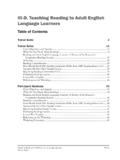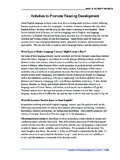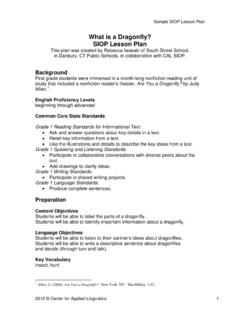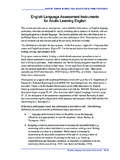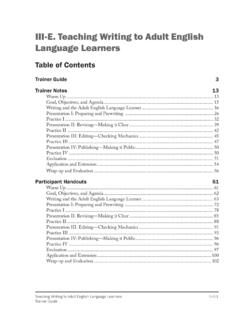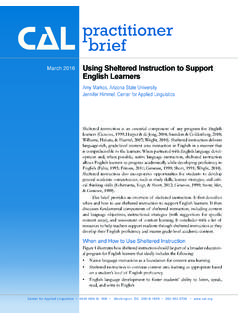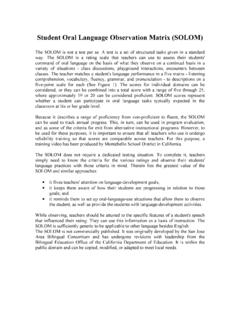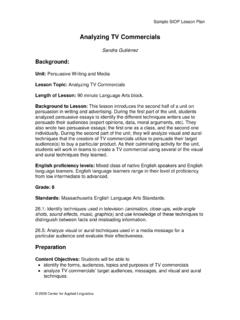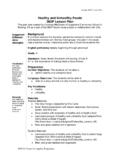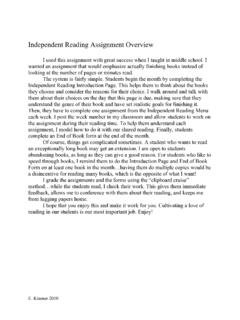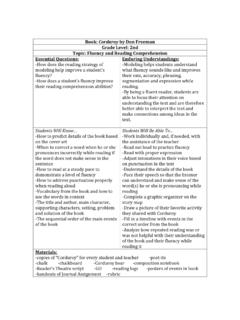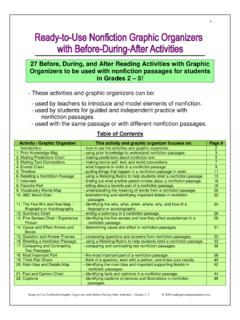Transcription of Differentiated Story Map Predict-O-Grams
1 CAL SIOP Anticipation Activity Adapted for SIOP by Annie Duguay and Lauren Artzi, CAL 2012 Center for Applied Linguistics 1 Differentiated Story Map Predict-O-Grams Content Objectives: Students will predict the elements and structure of a Story before reading . Students will review their predictions to monitor their comprehension. Language Objectives: Students will tell their Story predictions to a partner. Students will write their predictions on the Story map. Students will listen to a read-aloud and retell the Story to a partner based on their comprehension. Instructions for use: The Story Map predict -O-Gram is used as a pre- reading activity and is a modification from the predict -O-Gram activity reported in Blachowicz (1986)1.
2 In this adaptation of Blachowicz predict -O-Gram, students have an opportunity to predict the Story ( , Peppe the Lamplighter by Elisa Bartone2 The predict -O-Gram allows students to use learning strategies such as making predictions and self-monitoring comprehension. It also allows teachers to preview vocabulary and find out what students know before they begin a unit or a reading activity. Once students are exposed to the terms they will hear in the Story , they can monitor their listening for comprehension. Students also have the opportunity to practice their academic speaking skills by telling their predictions and retelling the Story to a partner. A follow-up writing activity where students are asked to write the events of the Story or summarize the Story , ensures that the activity includes all four language domains: reading terms, writing sentences, speaking to a partner, and listening to the teacher.)
3 There are also a lot of opportunities to build in higher order thinking skills, relating the Story to the Social Studies and English Language Arts curriculum. While Peppe the Lamplighter is a narrative text, this activity can be modified for most kinds of text structures by swapping the Story map with another kind of graphic organizer ( , Venn Diagram, Sequence Chain, etc.). ) by sorting the key terms (plot events, characters, important vocabulary, etc.) into the Story map below the terms ( , chart with setting, characters, etc.). This activity allows students to predict elements of the Story by using the four modalities of language reading , writing, speaking, and listening.
4 Before the teacher reads Peppe the Lamplighter aloud, she reviews the key terms that will appear in the Story . Then students can work with peers to complete their Story map predictions. In a less scaffolded version of this activity, students sort by writing the terms. The more scaffolded version includes pictures to help explain each term. Students might even cut and paste the terms and sort them into the categories of setting, characters, problem, and solution (without gluing). Once students have sorted the terms, they can tell their predictions to a partner. Later, after the read-aloud, teachers can check for comprehension by having the students resort the terms, glue them to the appropriate categories, and retell the Story to a partner, using the picture clues.
5 1 Blachowicz, C. (1986). Making connections: Alternatives to the vocabulary notebook. Journal of reading 29 (2), 643-649. 2 Bartone, E. (1993). Peppe the Lamplighter. New York: Harper Collins. CAL SIOP Anticipation Activity Adapted for SIOP by Annie Duguay and Lauren Artzi, CAL 2012 Center for Applied Linguistics 2 Story Map predict -O-Gram: More Scaffolded Version Peppe the Lamplighter by Elisa Bartone Name_____ Date_____ All of the words in the boxes are part of the plot of Peppe the Lamplighter. Decide if the words are part of the setting, characters, problem, or solution of the Story . Write the words on the lines below.
6 You may have more than one word in a square. tenement poor Peppe Little Italy no electricity scared of the dark happy Papa Mulberry Street sad light the lamps Setting _____ _____ _____ Characters _____ _____ _____ Problem _____ _____ _____ Solution _____ _____ _____ sisters CAL SIOP Anticipation Activity Adapted for SIOP by Annie Duguay and Lauren Artzi, CAL 2012 Center for Applied Linguistics 3 Story Map predict -O-Gram: Less Scaffolded Version Peppe the Lamplighter by Elisa Bartone Name_____ Date_____ Write these words on a square on the predict -O-Gram chart ( Story map below). You may have more than one word in a square. You might have an empty square.
7 Little Italy no electricity Peppe s sisters (Filomena, Assunta, Giulia, Mercucia, Nicolina, Adelina) poor Mulberry Street Tenement Peppe Papa angry job as a lamp lighter dark streets best job bad job joyful felt sad light the street lamps afraid of the dark Setting Characters Problem Action Solution Other Things
